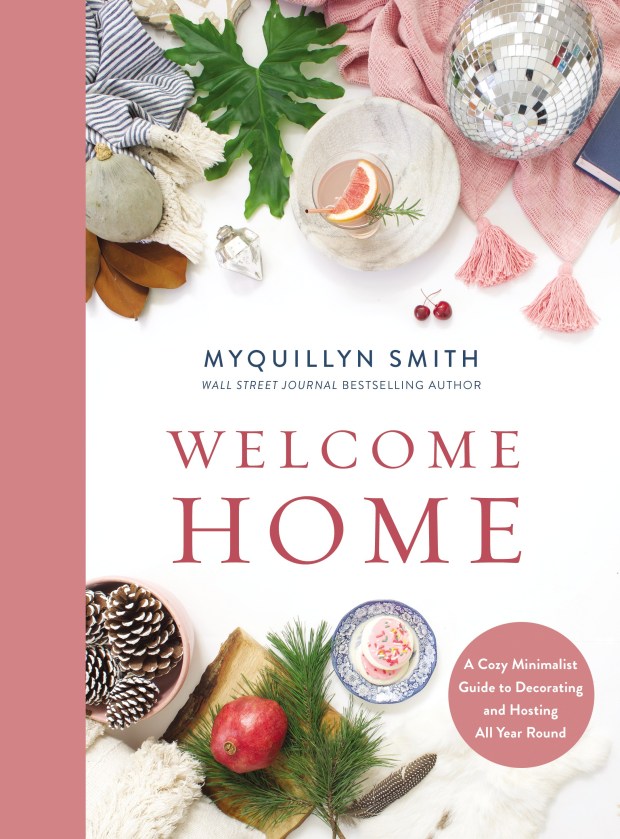Every so often in the world of home design you meet a refreshing pro who doesn’t take herself too seriously and who knows when and where to take the pressure off.
That’s true about Myquillyn Smith, (pronounced MIKE-willin), the voice behind The Nester blog and author of three books, including “Welcome Home: A Cozy Minimalist Guide to Decorating and Hosting All Year Round” ($27), due out Sept. 15 from Zondervan Publishing.
I got an advance copy, which came with this self-effacing author bio: “Myquillyn is a self-taught, design-school dropout who took a week-long course so she could be a certified home stager and redesigner.”
How could I not like this woman? That same humble confidence shows through in “Welcome Home.” I mean, anyone who writes this can be in my inner circle: “As much as I want my home to feel connected to the season that’s happening outside our walls, I’m not willing to devote more time, money and storage space than what’s needed.”
Later in the book, Smith promises that her decorating advice won’t involve any “elaborate DIY projects,” “precise measurements,” or “expensive, one-time-use party supplies.”
Yes, please.

The book’s four sections — divided, of course, by season — include decorating and hosting suggestions in tune with the outdoors, ideas to express seasonal rhythms that don’t involve dozens of color-coded plastic storage bins, and style moves that reflect the essence of nature, not the plastic and pretend representation of it.
With directives that include more style-less stuff, shop your house and shop your yard, Smith pumps the brakes on perfection, and teaches us her cozy minimalist ways.
“Most of us aren’t trying to make our homes look pretty, so our neighbors will be jealous,” she writes. “We want to love our homes so we can use them. We want our homes to look lovely so we can stop thinking about them already, so they’re always ready to welcome you, your family and your friends.”
Naturally, I had questions.
Q: We have much in common, including many moves. You’ve lived in 13 houses since you got married. (I’ve lived in 11, and I thought that was a lot.) How has that impacted you?
A: I still don’t remember my zip code. But looking back at all those moves, they were the best design education ever. You learn so much setting up a house.
Q: In your book you say, “Hosting is never about the host, and hospitality is never about the home.” Can you explain?
A: Like everything, I had to learn that the hard way. Having friends over used to be about me. I used to always feel like my house wasn’t ready enough or nice enough or perfect enough. But now I see a red flag when I’m having people over, and I’m concerned about my outfit and whether my house is up to snuff. If that’s what I’m worried about, I’m not in the best place to host. Hospitality is grace with throw pillows. It’s being in a place where we can connect. People miss out on connection when they focus on trying to impress others.
Q: What did you learn while writing this book?
A: I wrote this book out of frustration. The frustration was me scrolling on Pinterest and seeing all these wonderful fall décor photos. I remember one that had dozens of plastic pumpkins lining the stairs. Don’t get me wrong. It looked stunningly beautiful. But I thought, “Is this the standard? Is this the new bar?” I love seasonal décor, but buying every beautiful thing clogs up our lives and our homes. We do not need to go to Hobby Lobby and buy 67 plastic pumpkins that we’ll store for next year.
Q: What else do you wish more people knew?
A: To decorate for the season, you don’t have to rely on store-made factory décor. It’s more fun to go to a farmers market and find that big, quirky pumpkin, set it out all season, and throw it away after Thanksgiving. Then you honor nature and don’t have to store things in the attic.
Q: You talk a lot about not letting our things boss us around. What do you mean by that?
A: All those things you save year over year become the boss of us. We need to take back control. A big part of creating a home is paying attention to what our houses are saying. Some things in a room are bossy; some colors and styles are bossy. I don’t want a silk sofa bossing me to be careful. Our stuff needs to serve us, not vice versa.




